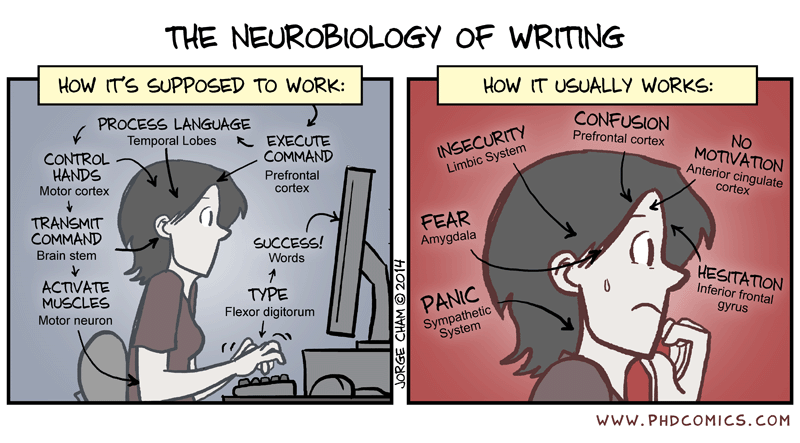
In this and upcoming posts guest writer Kathrin Spieker will share her thoughts and experience about how to improve writing skills specifically aimed for publishing in scientific journals. Kathrin is a young seismologist who has recently started publishing her research as part of her PhD study.
In this little series, I will talk about the three main parts of scientific publication. The first part will focus on the writing process. Is there an effective and easy way to write the papers that stack up on our to-do lists? The second part will continue after writing the paper: the submission to a journal and the revision along with re-submission of the paper. Finally, in the third part I will talk about being a good reviewer and how reviewing other papers can help you improving your writing.
Writing – the nemesis of a scientist?
Every one of us probably experienced it at least once – the reluctance of writing a manuscript, abstract, proposal etc. No doubt, writing can be a pain. It can be hard. It takes a lot of our time. Especially at the beginning of a scientific career a lot of people struggle with writing. For some the aversion will continue during their careers, others might find a way to even enjoy writing.

Do you have an idea for your story yet? Comic from http://www.gocomics.com/calvinandhobbes/1992/05/21
The plain truth is: Writing goes hand in hand with research. It is important to publish our results and let’s be honest – the feeling of accomplishing that is terrific. So, why do have many people problems to write? And can we do anything about it?
There is nothing to writing. All you do is sit down at a typewriter and bleed. – Ernest Hemingway
Well, we don’t want to bleed, we only want to fill pages with words. There are a lot of tips out there (books and websites) for becoming a better writer (for example, How to write great papers ). Although giving tips on writing will always be subjective, here are some rules of thumbs:
- Avoid distractions
- Start writing early in your research
-
Write in plain English
The book The Elements of Style by William Strunk, Jr. is highly recommended.
I can tell you what helped me to struggle less with the writing. There are days when I really enjoy writing. To be honest, the bad-writing days won’t go away, but they decrease:
-
Turn writing into a habit
Writing has less to do with talent then it has to do with practice. Just think about it: Why are you so good in your area of research? It is because you are confronted with it every single day. You train your ability of doing your research and therefore you become better. So, why are you not doing the exactly same with writing? For example, you could write every day for 15 minutes a short piece about what your research is about or what you have done or the papers you have read. Practice is the key! Have a look at the web page of Scisnack (http://www.scisnack.com/). This is a website dedicated to groups of early career scientists that meet every week to discuss short snacks on science that they wrote and that at the end will be published on their webpage. Discussion with other people helps to improve your writing. Eventually one gains writing practice by writing a few snacks per year. You can join the community of SciSnack and become an author there. Or, you could find some friends and colleagues to open your own writing group. Another possibility is to write something for this very blog. Just contact us!
-
Read a lot
Along with practicing writing, reading is an enormous boost for your writing skills. The more you read scientific papers, the more evolves the instinct on how to write a paper. Moreover, all of us have read at least one poorly written paper. Use this paper as a negative example! But, more important is to find a paper that you enjoy reading because it is written clearly. Put this paper on your desk and never remove it from there. It will be your go-to example and help you to write your manuscripts.
-
Topic sentences and bullet points are your friends
A book that I liked very much is Anne E. Greene’s Writing Science in Plain English. The best way to structure your manuscript and give it a continuous flow is by writing topic sentences for each paragraph. Think about what you really have to write in your paper. What are the main parts that should not be missed? Find your topic sentences. Reading only these sentences should sum up your whole manuscript. Afterwards expand from these topic sentences into paragraphs. Every paragraph should only have one topic sentence. If you have the bullet points for your paragraphs writing the paragraphs will be much easier.
After I now have spread my subjective “wisdom”, that might help or not, we want to learn from you. Share your tips, websites, books on writing! Leave a comment!
 Kathrin Spieker is currently a PhD student in seismology at the Department of Earth Science of the University of Bergen (Norway). She investigates globally the crustal and upper mantle structure using passive seismic imaging with the focus on teleseismic converted waves. You can contact Kathrin via e-mail: Kathrin.Spieker@uib.no.
Kathrin Spieker is currently a PhD student in seismology at the Department of Earth Science of the University of Bergen (Norway). She investigates globally the crustal and upper mantle structure using passive seismic imaging with the focus on teleseismic converted waves. You can contact Kathrin via e-mail: Kathrin.Spieker@uib.no.


Pingback: Seismology | Article submission and resubmission
Pingback: Seismology | Writing boost: Being a reviewer